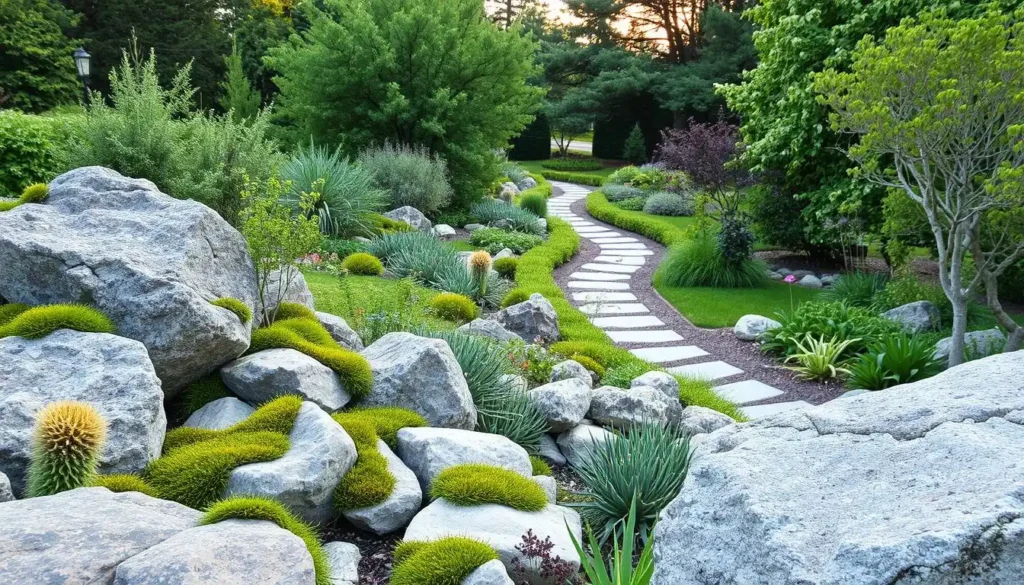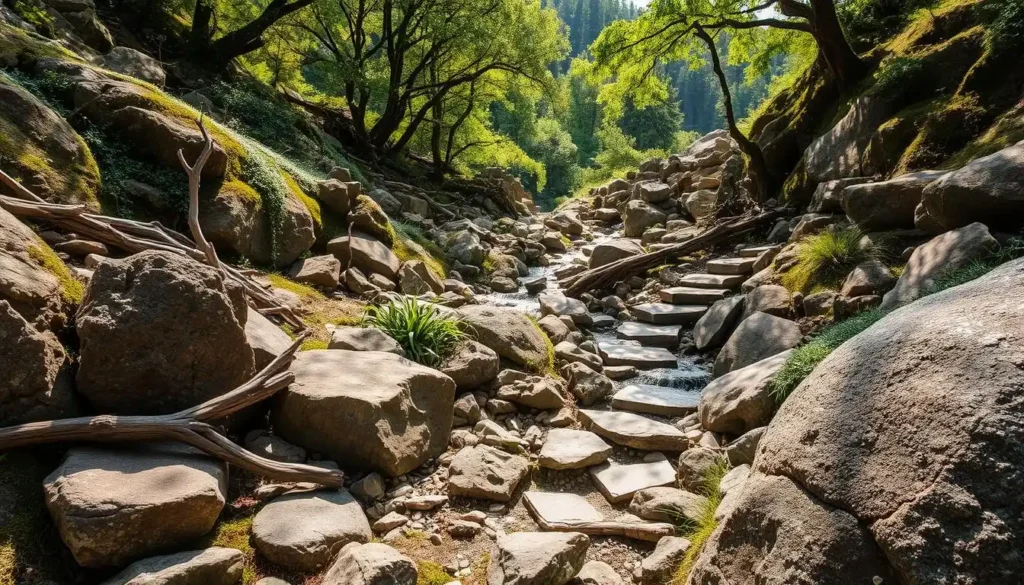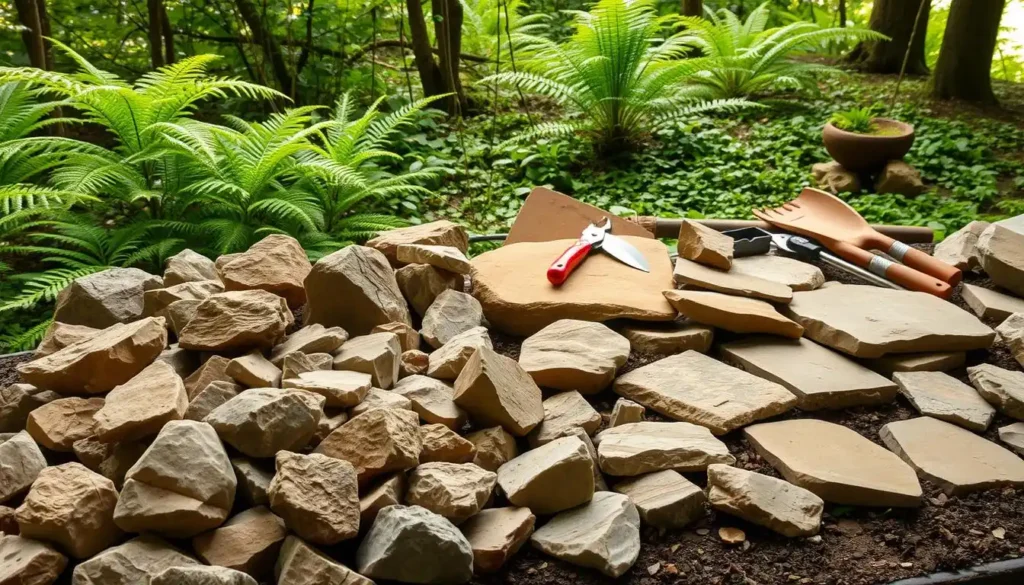Want to turn your outdoor area into a stunning oasis? A rockery garden is a great choice. It combines rocks, plants, and decorations for a unique look.
This article will share tips for a stunning rockery that matches your home. You’ll learn about picking plants and arranging rocks. It’s your guide to a beautiful outdoor space.
Key Takeaways
- Discover the benefits of incorporating a rockery into your outdoor design
- Learn how to choose the right plants and materials for your rockery garden
- Understand the importance of arrangement and placement in creating a visually appealing rockery
- Get tips on how to maintain your rockery garden for long-lasting beauty
- Explore creative ideas for enhancing your rockery’s aesthetic appeal
The Magic of Rockery Gardens in Modern Landscapes
Rockery gardens are now a key part of modern landscaping. They mix natural beauty with easy care. These gardens are not just pretty, but also home to many plants. They can make your outdoor area better.
Defining the Modern Rockery Garden
A modern rockery garden uses rocks, stones, and plants that love rocky places. It’s a versatile landscaping option that fits many climates and spaces.
Benefits of Adding a Rock Garden to Your Property
Having a rock garden on your property brings many benefits. Two main advantages are:
Aesthetic Appeal Throughout Seasons
Rock gardens look good all year. Plants bloom at different times, keeping your garden interesting all year.
Low Maintenance Advantages
Rock gardens need less care. They need less water and pruning than regular gardens.
| Benefits | Description |
|---|---|
| Aesthetic Appeal | Year-round visual interest with changing seasons |
| Low Maintenance | Less watering and pruning required |

Planning Your Perfect Rockery Garden Layout
Before you start building your rockery garden, it’s essential to plan the layout according to your yard’s conditions. A well-planned rockery garden can enhance your landscape ideas with rocks and create a unique outdoor space.
Assessing Your Space and Conditions
To create a thriving rockery garden, you need to assess the space available and the conditions it offers. This includes evaluating the sun exposure and drainage.
Sun Exposure Analysis
Most rockery plants require adequate sunlight. Assess the sun exposure in your yard to determine the best placement for your rockery garden. Consider the duration and intensity of sunlight throughout the day.
Drainage Considerations
Proper drainage is crucial to prevent waterlogged soil. Ensure your rockery garden has good drainage by selecting a site with natural slope or by creating a drainage system.
Creating a Design Blueprint
Once you’ve assessed your space, create a design blueprint. This involves sketching out your ideas and considering the scale and proportion of your rockery garden. Incorporate landscape ideas with rocks that complement your existing garden features.
Incorporating Natural Landscape Features
To make your rockery garden blend seamlessly with the surrounding landscape, incorporate natural features. This could include using native rocks and plants that are adapted to your local climate.

Essential Tools and Materials for Rock Garden Construction
To make a beautiful rock garden, you need the right tools and materials. The right equipment makes building easier and faster.
Must-Have Tools for the Job
Before starting, make sure you have these tools:
- Shovel: For digging and moving soil and rocks.
- Rake: To level the ground and remove debris.
- Wheelbarrow: For carrying heavy rocks and soil.
- Tamping Tool: To pack the soil and gravel.
Types of Rocks and Their Best Uses
Choosing the right rock is key for your garden’s look and strength.
Limestone vs. Sandstone vs. Granite
| Rock Type | Characteristics | Best Use |
|---|---|---|
| Limestone | Soft, sedimentary, can be porous | Decorative features, can be carved |
| Sandstone | Layered, can be fragile | Creating layered, textured effects |
| Granite | Hard, durable, resistant to weathering | Main structural elements, pathways |
Decorative Gravel Options
Decorative gravel adds beauty to your rock garden.
- Pea Gravel: Small, rounded stones, easy to walk on.
- Crushed Granite: Compactable, good for pathways.
- River Rocks: Smooth, rounded, come in various sizes.
Soil Mixtures for Optimal Plant Growth
The right soil mix is crucial for plant health.
A mix that drains well and holds moisture is best. You can make your own mix with potting soil, perlite, and compost.

How to Construct a Rock Garden: Step-by-Step Guide
Creating a stunning rock garden is easier than you think. It becomes the centerpiece of your landscape. Follow these steps to build a beautiful rock garden.
Site Preparation Techniques
Start by preparing the site. Clear it of debris, weeds, and plants. Also, check for underground utilities and mark their spots.
Laying the Foundation
Next, lay the foundation. Use compacted gravel or sand to ensure good drainage and prevent waterlogging.
Positioning Rocks for Maximum Impact
Choosing the right spot for rocks is key. Think about their size, shape, and color. This will make your garden look great.
When placing rocks, create planting pockets. Fill these with a soil mix that drains well. This supports your plants’ health.
Establishing Levels and Terraces
To add depth, create levels and terraces. Use rocks and soil. This prevents erosion and improves drainage.
Finishing Touches for a Natural Look
Finally, add a layer of mulch or gravel. This retains moisture, suppresses weeds, and gives a natural look.
| Step | Description |
|---|---|
| 1. Site Preparation | Clear the area, check for underground utilities |
| 2. Laying the Foundation | Create a layer of compacted gravel or sand |
| 3. Positioning Rocks | Place rocks strategically for maximum impact |
| 4. Creating Planting Pockets | Fill pockets with well-draining soil for rock garden plants |
Selecting the Perfect Rock Garden Plants
Choosing the right plants is crucial for a stunning rockery garden. The best plants for a rock garden are those that love rocky landscapes. They need to thrive in well-drained soil and full sun.
Alpine and Succulent Varieties
Alpine plants and succulents are perfect for rock gardens. They love well-drained soil and full sun. Saxifraga and Gentiana are great alpine plants. Sempervivum and Sedum are low-maintenance succulents.
Drought-Resistant Perennials
Drought-resistant perennials are also great for rock gardens. Yarrow and Lavender can handle dry conditions. They add beauty to your garden.
Seasonal Bloomers for Year-Round Interest
To keep your rock garden interesting all year, add seasonal bloomers.
Spring and Summer Stars
In spring and summer, plants like Crocus and Tulipa bloom. They bring vibrant colors to your garden during these months.
Fall and Winter Standouts
In fall and winter, Aster and Chrysanthemum add color. Plants with interesting foliage or berries also add winter interest.
Native Plant Options for American Gardens
Native plants are great for rock gardens because they fit local conditions. Black-eyed Susan and Butterfly Weed are good choices for American gardens.
By mixing different plants, you can make a dynamic and beautiful rock garden. It will thrive all year round.
Stunning Landscape Ideas with Rocks
Transform your outdoor space with stunning landscape ideas that incorporate rocks. Rock gardens can add a unique dimension to your landscape, providing a beautiful contrast to lush greenery.
Japanese-Inspired Rock Garden Designs
Japanese rock gardens are renowned for their serene beauty. They often feature carefully placed rocks, gravel, and minimalistic plantings. Creating a sense of tranquility is key to this style.
Mediterranean Rock Garden Styles
Mediterranean rock gardens often incorporate warm-toned rocks and drought-resistant plants like succulents. This style is perfect for warm, sunny climates.
Alpine-Themed Rock Gardens
Alpine rock gardens mimic mountainous landscapes. They often feature a mix of rocks and alpine plants that thrive in well-drained soil.
Creating Mini Mountain Landscapes
To create a mini mountain landscape, use a variety of rock sizes and shapes. Incorporate plants that grow at different heights to add depth.
Incorporating Scree and Moraine Features
Scree and moraine features can add realism to your alpine rock garden. Use small rocks and gravel to create these features.
Desert-Inspired Rock Gardens
Desert-inspired rock gardens feature rocks and plants native to arid regions. Cacti and succulents are popular choices for this style.
| Rock Garden Style | Key Features | Best Plants |
|---|---|---|
| Japanese | Gravel, minimalistic plantings | Moss, Japanese Maple |
| Mediterranean | Warm-toned rocks, succulents | Succulents, Lavender |
| Alpine | Mix of rocks, alpine plants | Alpine flowers, Sedum |
Transforming Challenging Spaces into Rockery Garden Masterpieces
You can make even tough yard spots look amazing with the right tricks. Rockery gardens are great for hard places because they can handle different conditions.
Sloped Areas and Hillsides
Slopes can be tricky, but they’re also a chance for creative designs. Use rocks and plants to keep the soil in place. Think about making terraces to add levels and interest.
Dry and Arid Locations
Dry spots need plants that don’t need much water and smart watering systems. Adding rocks and gravel helps keep moisture in. Drought-tolerant succulents are great for these areas.
Small Urban Spaces
Even tiny city spots can become rock gardens. Container gardens and balcony rock gardens are perfect for small areas.
Balcony Rock Gardens
Balconies can have many rock garden styles, from simple to complex. Pick containers that match your space and taste.
Container Rock Garden Ideas
Containers are flexible and can be moved. Choose plants that do well in containers and fit your design.
Water Features in Your Rockery Garden
Adding water features to your rockery garden can really boost its look. These elements not only make your garden more beautiful but also create a calming atmosphere. It turns your garden into a peaceful retreat.
Small Waterfalls and Cascades
Small waterfalls and cascades can add a lot of charm to your rock garden. They bring a sense of calm and movement. You can use rocks and a small pump to make the water flow.
Rock Pools and Basins
Rock pools and basins are great for adding water to your garden. They can blend right into your landscape, making everything look even more stunning. They also provide a reflective surface that highlights the garden’s beauty.
Dry Stream Beds for Visual Interest
Dry stream beds are a unique choice for your garden. They add interest without needing water. This is especially good if you’re trying to save water.
Creating the Illusion of Water
To make a dry stream bed look like it has water, use smooth rocks and pebbles. Arrange them to look like a stream. Adding plants that look like they grow in water can make it even more convincing.
Plant Selection for Dry Stream Beds
When picking plants for dry stream beds, choose ones that don’t need much water. Succulents and certain grasses are great choices. They can thrive in your rock garden’s conditions.
By adding these water features, your rockery garden will become a captivating place. It will draw your eye and calm your mind.
Lighting Your Rockery Garden for Dramatic Effect
Make your rockery garden a stunning sight with the right lighting. Good lighting makes your garden look better and lets you enjoy it at night too.
There are many ways to light up your rockery garden. Solar-powered lighting solutions are a green choice. They use the sun’s energy to light up your garden at night. They’re easy to set up and need little care.
Solar-Powered Lighting Solutions
Solar lights come in many styles. You can find stake lights for plants or string lights for rocks. They’re a smart, green way to brighten your garden.
Highlighting Focal Points with Spotlights
Spotlights can spotlight special parts of your garden. Like a stunning rock or a standout plant. This adds drama and interest.
Creating Ambiance with String Lights
String lights make your garden feel welcoming. You can wrap them around rocks or trees. They create a magical feel at night.
Seasonal Lighting Displays
Change your lights with the seasons to keep your garden fresh. Use warm lights in winter for a cozy feel. Use cool lights in summer to highlight plant colors.
With these lighting tips, your rockery garden will be a beautiful, inviting spot. Enjoy it for many years.
Seasonal Maintenance Tips for a Thriving Rockery Garden
To keep your rockery garden thriving, you’ll need to perform specific maintenance tasks throughout the year. As the seasons change, your garden’s needs will shift, requiring adjustments in care and attention.
Spring Care Routines
In the spring, your rockery garden will need some TLC after the cold winter months. Start by removing any dead plant material and debris that may have accumulated. Prune and trim plants to maintain their shape and promote healthy growth.
- Remove weeds and debris
- Apply a balanced fertilizer
- Check for signs of pests or diseases
Summer Maintenance Hacks
During the summer, your rockery garden will require regular watering and maintenance. Monitor soil moisture and adjust your watering schedule accordingly. Keep an eye out for signs of pests or diseases, and take action promptly if you notice any issues.
Fall and Winter Protection Strategies
As the seasons change, your rockery garden will need protection from the elements. Apply a layer of mulch to insulate the soil and protect sensitive plants. Consider using protective coverings or bringing plants indoors if necessary.
Protecting Sensitive Plants
Some plants may be more sensitive to extreme weather conditions. Take extra care to protect these plants by using burlap or frost cloth to shield them from harsh winds and frost.
Managing Snow and Ice on Rock Structures
When snow and ice accumulate on your rock structures, take care to remove them gently to avoid damaging the rocks or plants. Use a soft-bristled brush or a gentle stream of water to remove snow and ice.
Budget-Friendly Rockery Garden Ideas
Creating a stunning rockery garden doesn’t have to be expensive. With a little creativity and resourcefulness, you can make a beautiful outdoor space. It will match your home’s landscape perfectly.
Sourcing Rocks Economically
Getting rocks for your garden can be costly. But, there are ways to find rocks without spending too much.
Local Quarries and Construction Sites
Check out local quarries or construction sites for rocks. They often have extra materials they might give away or sell cheaply.
Repurposing Existing Materials
Look around your property for rocks or stones to reuse. This saves money and adds a personal touch to your garden.
DIY Rock Garden Accessories
Make your own garden accessories instead of buying them. You can make stepping stones, benches, or borders with materials like concrete, wood, or recycled items.
Propagating Plants to Save Money
Propagating plants from seeds or cuttings saves money. Many rock garden plants are easy to grow from cuttings and can do well in the right conditions.
Phased Construction Approaches
Build your rockery garden in phases. Start small and grow it as your budget allows. This way, you can manage costs and make changes as needed.
By using these budget-friendly tips, you can create a beautiful rockery garden. It will enhance your outdoor space without breaking the bank.
Conclusion: Creating Your Own Jaw-Dropping Rockery Garden
A well-designed rockery garden can turn your outdoor area into a stunning oasis. By mixing the right rocks, plants, and design, you can make a unique and eye-catching landscape. It will show off your personal style.
You now have the knowledge and inspiration to start your own rockery garden. Whether you have a small urban area or a big backyard, the tips in this article will guide you. You can make a beautiful rockery garden that makes your property look better and more valuable.
With careful planning, attention to detail, and creativity, you can make your rockery garden dream come true. So, why wait? Begin planning your rockery garden today. Enjoy the beauty and peace it brings to your outdoor space.
FAQ
What are the best rock garden plants for a dry climate?
For a dry climate, choose drought-resistant plants. Succulents, alpines, and certain perennials work well. Sedum, sempervivum, and delosperma are good examples.
How do I construct a rock garden on a slope?
Start by assessing the site and designing a layout that fits the terrain. Use rocks and gravel to stabilize the soil. Creating terraces adds visual interest.
What types of rocks are best for a rock garden?
The best rocks depend on your style and local geology. Limestone, sandstone, granite, and decorative gravel are popular. Think about color, texture, and durability when choosing.
How do I incorporate water features into my rock garden?
Add water features like small waterfalls or rock pools. Use solar-powered pumps or self-circulating systems for low maintenance.
What are some budget-friendly ways to create a rock garden?
Save money by using local rocks and repurposing materials. DIY accessories and propagate plants to cut costs. Build it in phases.
How do I maintain my rock garden during the winter?
Protect plants from frost and snow. Avoid using salt or sand on rock structures. Use evergreen branches or burlap for protection.
What are some creative ways to use rocks in landscape design?
Rocks can create Japanese, Mediterranean, alpine, or desert gardens. Use them in pathways, borders, and decorative accents.
How do I choose the right plants for my rock garden?
Consider climate, soil, and maintenance needs. Choose plants that like well-draining soil and local temperatures. Native plants or region-specific plants are good choices.

